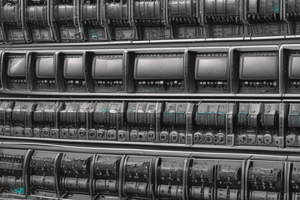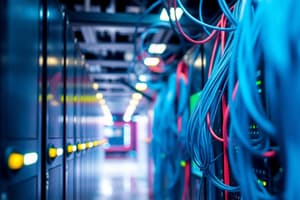Podcast
Questions and Answers
What is the primary function of a repeater in a LAN?
What is the primary function of a repeater in a LAN?
- To connect devices at the network layer
- To implement an access method
- To extend the geographical range of a LAN (correct)
- To connect multiple networks
What layer of the OSI model do repeaters operate on?
What layer of the OSI model do repeaters operate on?
- Transport layer
- Network layer
- Physical layer (correct)
- Data link layer
What happens when two nodes on connected segments transmit at the same time in a repeater-based network?
What happens when two nodes on connected segments transmit at the same time in a repeater-based network?
- The repeater buffers the data
- One node has priority over the other
- The repeater resolves the collision
- A collision occurs (correct)
What type of topology is formed when using a hub?
What type of topology is formed when using a hub?
How does a hub handle incoming data from an adapter?
How does a hub handle incoming data from an adapter?
What is the primary function of a bridge in a network?
What is the primary function of a bridge in a network?
How many categories of connecting devices are mentioned in the chapter?
How many categories of connecting devices are mentioned in the chapter?
What type of device acts on frames or packets?
What type of device acts on frames or packets?
What is the primary function of a bridge?
What is the primary function of a bridge?
What is the main difference between a switch and a bridge?
What is the main difference between a switch and a bridge?
What is the advantage of cut-through switching in switches?
What is the advantage of cut-through switching in switches?
What is the main function of a router?
What is the main function of a router?
What is the difference between a switch and a router?
What is the difference between a switch and a router?
What is the disadvantage of cut-through switching?
What is the disadvantage of cut-through switching?
What is the function of a router in terms of broadcast domains?
What is the function of a router in terms of broadcast domains?
What do routers use to determine the best route?
What do routers use to determine the best route?
What is a key difference between a hub and a bridge?
What is a key difference between a hub and a bridge?
What is the primary advantage of using a backbone hub?
What is the primary advantage of using a backbone hub?
What is a consequence of interconnecting multiple LAN segments with a hub?
What is a consequence of interconnecting multiple LAN segments with a hub?
What is a characteristic of a bridge's operation?
What is a characteristic of a bridge's operation?
What is a key difference between a collision domain and a broadcast domain?
What is a key difference between a collision domain and a broadcast domain?
How does a bridge divide a LAN?
How does a bridge divide a LAN?
What is a limitation of using a hub?
What is a limitation of using a hub?
What is the function of a bridge in a network?
What is the function of a bridge in a network?
Flashcards are hidden until you start studying
Study Notes
Connecting Devices in Computer Networks
Functions of Network Devices
- Separating (connecting) networks or expanding a network
- Examples: Repeaters, Hubs, Bridges, Switches, Routers
Five Connecting Devices
- Repeaters
- Hubs
- Bridges
- Switches
- Routers
Repeaters
- A physical layer device that acts on bits, not on frames or packets
- Regenerates incoming bits and transmits them onto all other interfaces
- Used in LAN to connect cable segments and extend the maximum cable length
- Does not implement any access method, so collisions can occur
Hubs
- Acts on the physical layer, operating on bits rather than frames
- Used to connect stations in a physical star topology, but logically a bus
- Receives a bit from an adapter and sends it to all other adapters without filtering
- Multiple Hubs can be used to extend the network length
- Forms a single collision domain and a single broadcast domain
Bridges
- Acts on the data link layer (MAC address level)
- Used to divide (segment) a LAN into smaller LAN segments or to connect LANs with identical physical and data link layers protocol
- Each LAN segment is a separate collision domain
- Performs filtering using a table, unlike Hubs and Repeaters
- Connects LANs, whereas Switches connect individual computers
Switches
- Usually used to connect individual computers, not LANs like Bridges
- Allows multiple devices connected to the switch to transmit simultaneously
- Operates in Full-duplex mode, sending and receiving frames simultaneously
- Performs MAC address recognition and frame forwarding in hardware
- Types of Switches include:
- Store-and-forward switching: receives entire frame before forwarding
- Cut-through switching: forwards frames when enough is received to make a forwarding decision
Routers
- Operates at the network layer, dealing with packets not frames
- Connects LANs and WANs with similar or different protocols together
- Isolates both collision domains and broadcast domains
- Acts like normal stations on a network, but has multiple network addresses
- Communicates with other Routers, exchanging routing information
- Determines the best route using a routing algorithm and special software
Studying That Suits You
Use AI to generate personalized quizzes and flashcards to suit your learning preferences.




